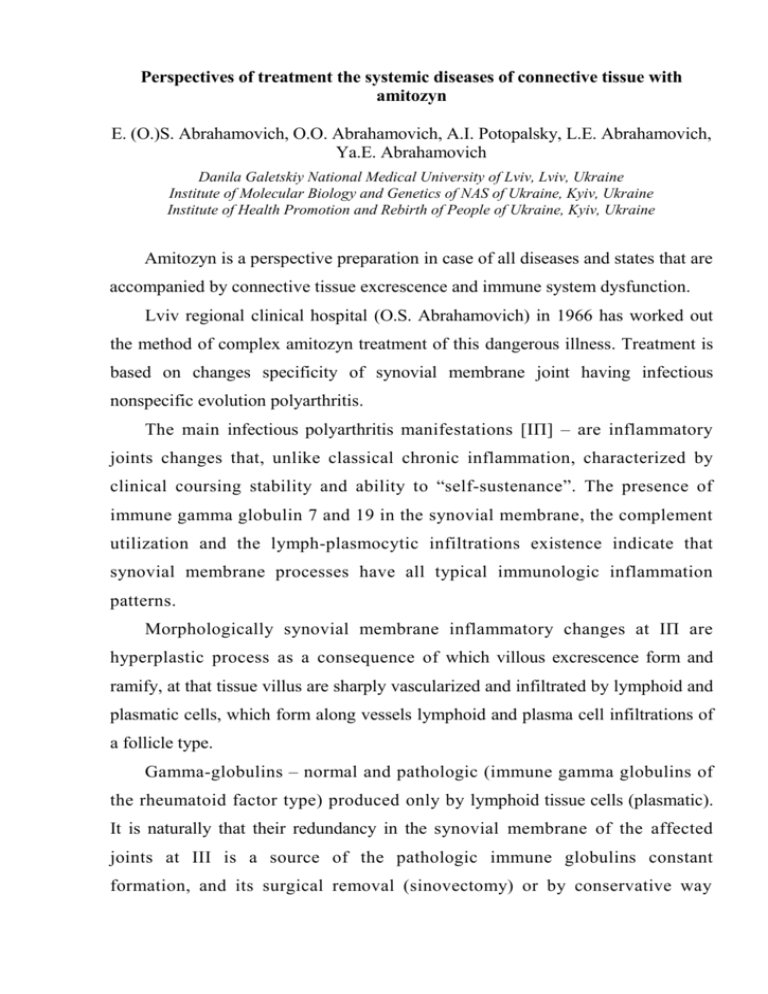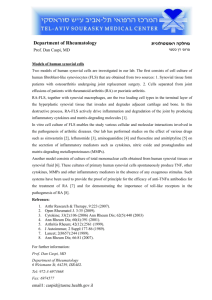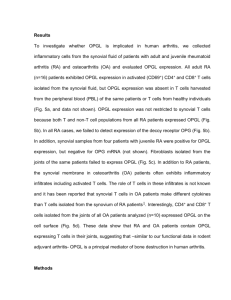Perspectives of treatment the systemic diseases of connective
advertisement

Perspectives of treatment the systemic diseases of connective tissue with amitozyn E. (O.)S. Abrahamovich, O.O. Abrahamovich, A.I. Potopalsky, L.E. Abrahamovich, Ya.E. Abrahamovich Danila Galetskiy National Medical University of Lviv, Lviv, Ukraine Institute of Molecular Biology and Genetics of NAS of Ukraine, Kyiv, Ukraine Institute of Health Promotion and Rebirth of People of Ukraine, Kyiv, Ukraine Amitozyn is a perspective preparation in case of all diseases and states that are accompanied by connective tissue excrescence and immune system dysfunction. Lviv regional clinical hospital (O.S. Abrahamovich) in 1966 has worked out the method of complex amitozyn treatment of this dangerous illness. Treatment is based on changes specificity of synovial membrane joint having infectious nonspecific evolution polyarthritis. The main infectious polyarthritis manifestations [ІП] – are inflammatory joints changes that, unlike classical chronic inflammation, characterized by clinical coursing stability and ability to “self-sustenance”. The presence of immune gamma globulin 7 and 19 in the synovial membrane, the complement utilization and the lymph-plasmocytic infiltrations existence indicate that synovial membrane processes have all typical immunologic inflammation patterns. Morphologically synovial membrane inflammatory changes at ІП are hyperplastic process as a consequence of which villous excrescence form and ramify, at that tissue villus are sharply vascularized and infiltrated by lymphoid and plasmatic cells, which form along vessels lymphoid and plasma cell infiltrations of a follicle type. Gamma-globulins – normal and pathologic (immune gamma globulins of the rheumatoid factor type) produced only by lymphoid tissue cells (plasmatic). It is naturally that their redundancy in the synovial membrane of the affected joints at III is a source of the pathologic immune globulins constant formation, and its surgical removal (sinovectomy) or by conservative way with use of antineoplastic (cytostatic) preparations is completely justified and scientifically valid. One of the arguments of such opinion and amitozyn use at III correctness is an experience of the domestic and foreign researchers, that in certain cases after total removal of the pathologically changed synovial membrane (with presence of the dense plasma cell infiltration and its depositing of the rheumatoid factor in the membrane), achieved a considerable improvement of the clinical course as a whole and even recovery, while use of the local and general corticosteroid therapy resulted only in decreasing of the inflammatory processes acuity in the affected joint. Surgeons, based on this fact, offer to conduct total sinovectomy with the aim of removal the lesion focus that is the main source of pathologic immunoglobulin. Thus, the radical cure experience after total sinovectomy conduction proves not only modern opinion concerning pathogenesis of the infectious non-specific polyarthritis (infectional arthritis) appropriateness, but also maintains correctness and validity of a new pathogenetically proved method of the bloodless radical treatment of this severe disease with use of antineoplastic agent amitozyn. The offered method has a character of partial etiopathogenetic therapy and is a method, more radical and effective comparing to the other ones, and can be compared only to the radical surgical operation – sinovectomy, widely recommended by the research institute of rheumatism and central research institute of traumatic and orthopaedic surgery, but in general the patients refuse this operation. Clinical practice showed that infectional arthritis patients’ treatment with glucocorticoids at this stage is not completely justified as an independent method of treatment, because it doesn’t give stable effect, sharply inhibits body resistance and at durable use brings on hypercorticism side effects. Amitozyn preparation (AM) – refined sum of celandine alkaloids “Chelidonium majus” thiophosphamide derivative, synthesized in 1959 by A.I. Potopalsky, has been recommended by Ministry of Health of Ukraine for clinical approbation as cytostatic agent. In 1966, after scientific substantiation and elaboration of the method, we first used AM as immunomodulator and antiviral preparation in complex treatment of the serious forms of connective tissue systemic disease (CTSD): rheumatoid arthritis (RA), systemic lupus erythematosus (SLE), systemic dermatosclerosis (SDS), systemic vasculitis (SV), and systemic dermatosis – rosacea disease (RD) of the third and fourth stages. Further researches of AM mechanism of action proved its evident antiviral, immunomodulatory, antiserotonin effects on malignant cells and pathologically changed synovial membranes that confirmed our conception appropriateness in the complex treatment of CTSD. 122 patients of the examined group were observed and treated (women – 100, men – 22, from the age of 21-56 years old, among them 79 – with RA, 11 – with SLE, 12 – with SDS, 9 – with SV, 11—with RD) with antecedent anamnesis beginning from 1 to 10 years. AM at dose 0.05 g was introduced intramuscular in a day, 20 injections per course. Along with this course, seriously ill patients with RA had the extra intra-articular introductions from 25 mg to 50 mg depending on affected joint sizes 1 time in 10 days – 5 injections per course. The first course was conducted stationary, the next 5-6 courses with one month breaks – on an outpatient basis. The treatment efficiency was evaluated directly after the ending of the 1 st course and during 30 years observation after the end of several courses. Clinical-functional, laboratorialbiochemical and immunological criteria and also remissions duration and work capacity indexes of the treated patients were used. It was determined that all the AM treated patients had positive short and long-term treatment results: excellent effectiveness had 2.08 %, good one – 79.17 %, satisfactory – 18.75 %, unsatisfactory and lethal results were not registered. In control group (the analogous examined group of 106 patients that were treated without AM use) were the same indexes: 0.91%, 68.04%, 27.85%, 2.74%, and 0.46% correspondingly. Stable clinical-morphologic remission lasted on average 14.9 ± 1.1 years of the patients with RA, 12.7 ± 3.7 years – with SLE, 9.6 ± 1.2 years – with SDS, 11.5 ± 1.5 years – with SV, and 10.7 ± 1.3 years – with RD that allowed in most cases to reduce dose or to cancel nonsteroid antiinflammatory preparations and glucocorticoids. Work capacity was saved in 79.17 % cases of the treated patients. Thus, the obtained results testify high amitozyn effectiveness and allow recommending its use in complex treatment of the serious forms of connective tissue systemic disease.








